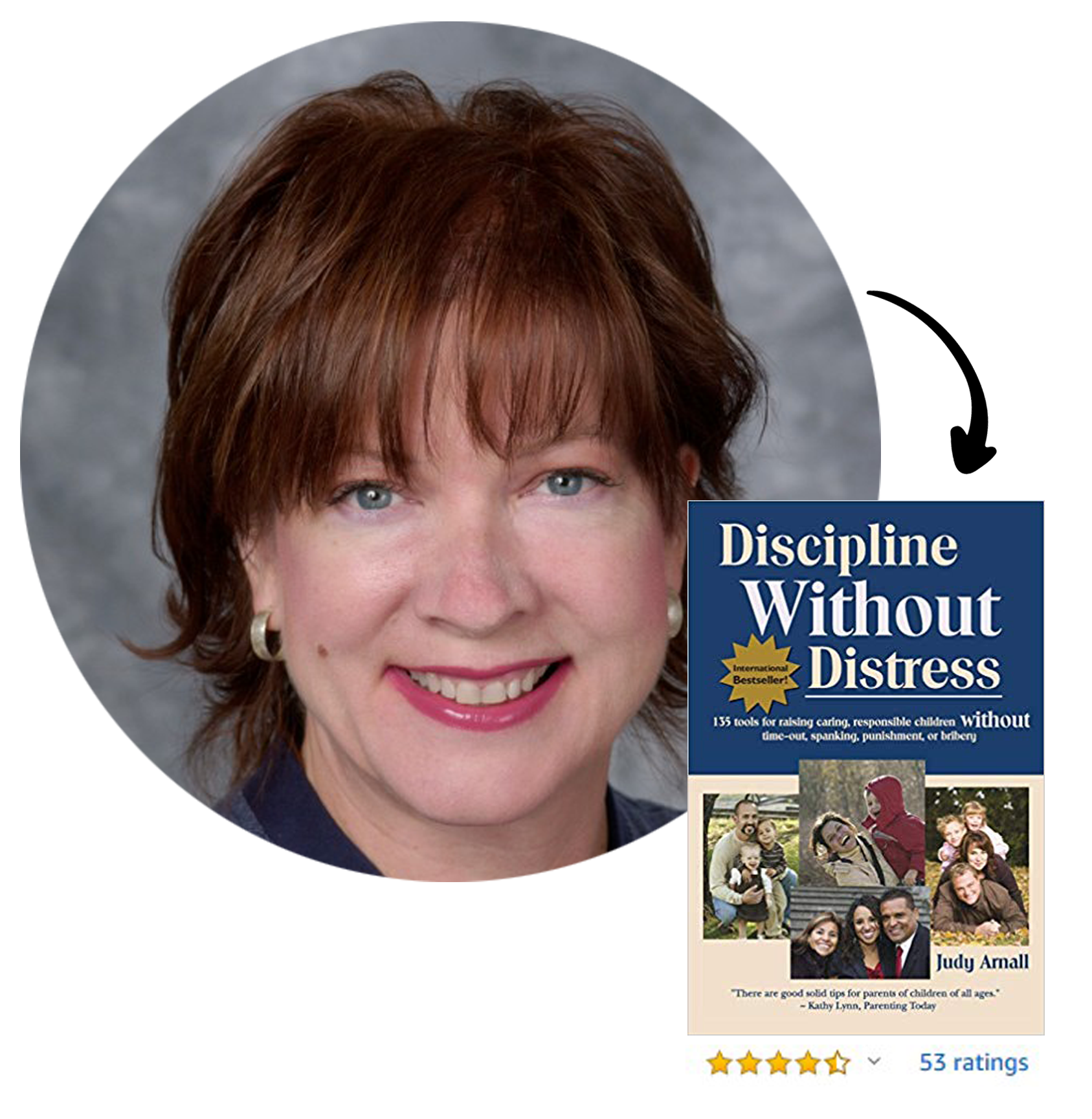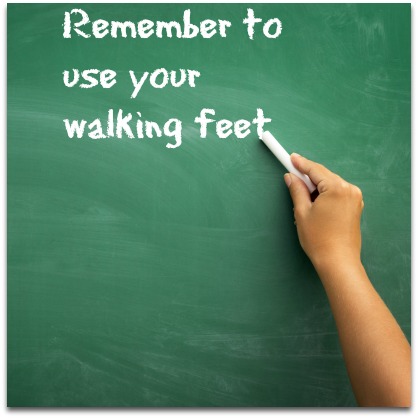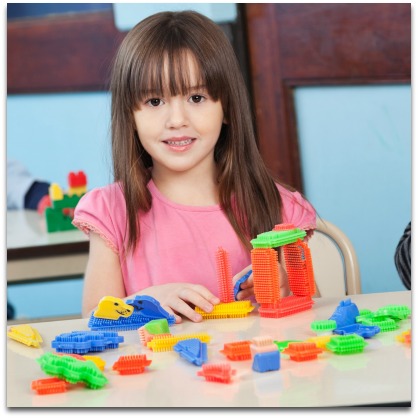 Have you noticed how kids behave differently at school than at home?
Have you noticed how kids behave differently at school than at home?
As an early education teacher, one of the most common questions I get from parents when they see their kids voluntarily cleaning up the classroom or sharing happily with other kids is:
How do you do that? My son always throws his stuff around at home and doesn’t like sharing toys with his brother! How do you get him to cleanup and share here without grumbling and drama?
I am also a mother of four. Over the years, I’ve taken some of the effective classroom discipline techniques and applied them at home. And they’re as effective at home as they are in the classroom.
Today, I’d like to share with you the 6 secrets of highly effective discipline.
#1: Effective discipline is NOT about punishment!
Discipline comes from the Latin word “disciplinare”, which means, “to teach.”
I’m completely aware of Merriam-Webster’s definition as “punishment” and it is why so many parents dread being the disciplinarian, but discipline that actually works is NEVER about punishment.
Discipline is simply a way to guide and manage a child’s behavior.
Discipline is based on the quality of a child’s relationship with the care provider (a teacher in the classroom; mom and dad at home). When a child receives consistent response from a caring adult, trust, deep attachment and a sense of being wanted develops. This forms the foundation of good behavior and effective discipline.
The key is to ensure that these relationships are respectful, responsive and reciprocal.
As a teacher I understood establishing a daily routine and frequent communication was vital to developing respectful and meaningful relationships which directly affect behavior and a child’s ability to learn.
For instance, as children arrive at my classroom, I always make sure to greet them at the door; just as they greet me. I’m never “busy” planning curriculum, checking attendance or talking, texting or tinkering with my phone at drop off and pick up times. To take no notice of a child left in my care would send a message saying, “You’re not worth my time” which begins a cycle of mistrust.
At home, one way I put being respectful, responsive and reciprocal into practice is by setting my alarm clock 30 minutes before my daughter needs to start getting ready for school. Not so I can begin my day with peace and quiet, but so I can wake her gently.
First, I turn on the light and call out her name and announce it is time to start thinking about getting up. After two or three minutes, I go to her room again, pull the covers and hair away from her face and tell her “It’s time to start getting up.” She’ll usually mutter along the lines of “I am trying” with her arms wrapped around my waist and her head buried in my stomach. I give her a big squeeze and a smooch on top of her head and tell her “Go to the bathroom.”
In a few minutes I go into the bathroom to find her mostly asleep on the toilet, with her elbows on her knees and her head in her hands. I call out to her again “wake up and brush your teeth” and she rises from her throne before I head downstairs to make her lunch.
I can hear the resounding “AIN’T NOBODY GOT TIME FOR THAT!” echoing in my head, but how would you react if your partner came running into your room quarter past 7, hollering for you to get up, tearing the blankets off of you, pulling you out of bed and shoving you into the bathroom? I know in my house there would definitely be a fight.
My daughter isn’t trying to be difficult. Nor is she spoiled, and she certainly doesn’t stay up late. She just needs some time in the mornings before she is ready to take on the day.
When I adjust my expectations according to that instead of punishing her, things go a lot smoother.
 Do you find yourself using punishment with your children because you have no idea how else to discipline? We partnered with Judy Arnall, college professor, expert, and best-selling author, to better understand how punishment often works against our parenting goals and to explore non-punitive discipline tools that actually work.
Do you find yourself using punishment with your children because you have no idea how else to discipline? We partnered with Judy Arnall, college professor, expert, and best-selling author, to better understand how punishment often works against our parenting goals and to explore non-punitive discipline tools that actually work.
This packed masterclass is one of the 70+ masterclasses you get when you join the AFineParent Academy today. Click here to learn more.
#2: Effective discipline is about positive reinforcement
 Positive reinforcement comes in many flavors: smiling, sharing a high five and giving effective praise.
Positive reinforcement comes in many flavors: smiling, sharing a high five and giving effective praise.
In the classroom, I’ve noticed that effective praise is selective, specific, encouraging and positive. It avoids comparisons and competition. It compares a child’s progress with his/her past performance rather than with other children and it’s delivered in a caring, natural tone of voice. Believe me children know when you’re just blowing smoke.
Also, I try to avoid using blanket phrases like “good job” or “good girl/boy” and be specific about the action or observed good behavior.
The most effective of all techniques, however, is to catch children being good or in an act of kindness. The reward and acknowledgement will be more genuine than if your child runs up to you and says he cleaned his room or shared his cookie with his baby sister.
When an older child tied the shoes of a younger child in my class, I was all over it; I told him what he did was caring and kind. Then I drew attention to the facial expression of the girl he helped; she was smiling. When I asked her how she felt she replied “Good”.
At home this translates to making sure we stay away from comparison between siblings, calling names or using labels and copping out using standby phrases like “good job”.
Positive reinforcement can also be tangible; for example, stickers, prizes and charts, but use it only as a last resort and for a short amount of time.
#3: Effective discipline is about modeling the right behavior
 In addition to offering positive reinforcement, modeling appropriate behavior is equally important. Be mindful of what you say and how you say it — not just when you are talking to your child, but when dealing with others as well.
In addition to offering positive reinforcement, modeling appropriate behavior is equally important. Be mindful of what you say and how you say it — not just when you are talking to your child, but when dealing with others as well.
Modeling provides visual clues to what acceptable behavior is and indirectly reinforces the appropriate way to act.
Consider for example what happens in your car. Suppose you’re driving down the highway when suddenly you notice the car behind you is barely inches from your bumper, then the driver begins flashing the high beam and leaning on the horn.
Most people would let loose a slew of obscenities, jam on the brake and maybe throw up a “friendly” hand gesture, but suppose instead you slowdown in an attempt to get the aggressive driver pass you or you change lanes and let the hurried driver pass.
The first scenario can be confusing to your child if you’re always reminding them to “use nice words” and showing joy when you catch them using nice words. What is being demonstrated is the opposite — a lack of self-control — and conveys that you don’t have to use nice words when you’re angry. The second scenario demonstrates proper problem-solving skills by remaining calm and not endangering others on the road despite being angry.
One of my worst habits in the toddler room was sitting on tables and other furniture (because infant/toddler furniture is infant/toddler sized). I wasn’t aware I was doing it until I found myself in a full-blown conversation with a tot sitting beside me on a shelf. And even though climbing is important to gross motor development at this stage, climbing furniture isn’t something that I want to encourage my kids to do (especially if I’m not there to provide the necessary supervision!)
#4: Effective discipline is about providing the right guidance
 When you guide your kids, always be direct. Give reasons and explanations for rules (keep it simple for young children).
When you guide your kids, always be direct. Give reasons and explanations for rules (keep it simple for young children).
And always, make sure directions and requests state what to do opposed to what not to do.
For instance, in my classroom, I focus on reminding children to “walk their feet” and explaining how walking keeps them from getting hurt, instead of just saying “don’t run”. It will help to drive the notion home if you retell a story of when your child was running and got hurt.
I even speak to my teenager in a similar way. For example, “It’s late and you have practice in the morning. You should get to bed in 15 minutes so you won’t be too tired. Last weekend you were late because you overslept.” Sometimes he does go up on his own. Sometimes 15 minutes pass and I need to jog his memory again. But he hardly ever gives me a hard time.
#5: Prevention is the most effective form of discipline
This kind of “discipline” in my opinion is what will preserve your sanity. Why would I tell my baby to stay off the stairs a million times a day when I can install a safety gate? Or make extra work for myself lifting children to the sink every time they need to wash their hands, whereas placing a stool at the sink will allow them to access the soap, water and paper towels themselves.
Prevention not only is a great form of discipline but also supports self-help skills and builds self-esteem.
An important aspect of prevention is planning. Don’t go grocery shopping with your toddler during a time he normally rests. Do not abruptly interrupt play (or other activity) and expect your child to cooperatively and quickly get ready to leave so you can try to be on time for your appointment that’s in 20 minutes, on the other side of town.
Also, be proactive. If there are specific shows or channels you don’t want your child watching, set parental codes on your TV. The same can be done on computers and mobile devices.
Being proactive prevents most arguments and negotiating, allowing you to spend more quality time with your child, instead of putting out fires all day long.
Here are a few more tips to embrace the prevention attitude:
- Avoid speaking to your child from across the room or the playground – it’s easy for them to not hear you or ignore you, and that can result in unnecessary issues.
- Give children as much notice as possible when changing activities, leaving the house and a change in the schedule. At school, five minutes before I need children to start cleaning up to transition to the next activity, I tell them “In five minutes we’ll start cleaning up so we can do music time”. Similarly at home before heading out to pick up my older kids from school, I tell my younger ones “In five minutes you need to put away the crayons and we’re going to get sister and brother.”
- Young children are concrete, literal thinkers and the concept of time is way too abstract for them to grasp. Try setting a timer or pointing to where the minute hand on the clock will be at clean- up time. Alternatively, you can completely avoid time and use a different format that they can grasp — for instance, if you were leaving the park you might say, “Two more times down the slide and then we are leaving.”
And sometimes, you just need to walk away and let another adult handle the situation to prevent it from escalating.
I will never forget my first experience with a child who had a behavioral disorder. He wasn’t able to lie down on a cot and rest. He spent rest time at a table usually working on jigsaw puzzles (he was a puzzle machine!) and helping with tasks such as sorting toys and games.
However, rest time is also used to give staff breaks and when teachers do most of their planning. This child would constantly interrupt me while talking with parents or other staff. He begged and pleaded for my undivided attention and company. It began to disturb the rest of the other children and he would call to them to leave their cots and come play with him.
Eventually the other teachers and I decided that I should take my break at the beginning of rest time while the other teachers helped the children who wanted to rest. (This was hard for me because rest time is my favorite time to get in one-on-one interactions). Then when I returned (provided he had been behaving while I was gone) I would spend about 20-30 minutes with him working on a puzzle or playing a quiet game of Uno.
As a parent, you need to seek out a similar support system so you can periodically step away from a situation and let another responsible adult (the other parent, grand parent, nanny, babysitter etc.) take over.
#6: When all else fails, use Time-ins
 “Time-ins” are helpful for children school aged and younger. Time-ins are similar to a “time out” in the sense they both remove the child from a situation that causing them distress or harm. The difference, however, is huge. Instead of sitting students down at an empty table alone feeling bad about himself I created several spaces in my classroom where child could go to or be brought to when feelings become so overwhelming, they interfere with the problem-solving process.
“Time-ins” are helpful for children school aged and younger. Time-ins are similar to a “time out” in the sense they both remove the child from a situation that causing them distress or harm. The difference, however, is huge. Instead of sitting students down at an empty table alone feeling bad about himself I created several spaces in my classroom where child could go to or be brought to when feelings become so overwhelming, they interfere with the problem-solving process.
These areas were private, cozy spaces in the nooks and crannies of my classroom that included soft, over-sized pillows, a class photo album, a small selection of books and quiet objects such as sensory or calming jars, Magana-doodle-esque boards and boxes sorted by themes of quiet, calming activities like magna-tiles or puppets.
Same as a time-out, a time-in should only last one minute per year of life (unless the child chooses to stay longer).
When the time is up, I ask the child if he knows why he had to be separated from the group, then I help him think of better ways he could have solved the problem instead.
At home I have a similar space in my living room and in the two younger children’s bedroom because they share.
The above methods and examples meet a child’s/children’s basic needs, provide opportunities for learning and development and improve competence and confidence.
Negative reinforcement, such as spanking or time-out only seem to work at first because of shock value and over time it becomes less effective.
So, there you have it – classroom discipline secrets that are as effective at home.
As you try them out, keep in mind that behavior doesn’t change overnight. Teachers like me work with scores of children on a daily basis. And still, discipline is something that takes us years of studying, practicing and reflecting to get a handle on.
As parents, it can be a lot more difficult. Give yourself a lot of grace. Get support; allow your partner, family and friends to pitch in and always remember to take time out to recharge your batteries.
The 2-Minute Action Plan for Fine Parents
For our two minutes contemplation today, let’s take stock of where we are at with the way we discipline…
- When you hear the word “discipline” does it automatically make you think “punishment”? How does this impact the way you approach a troubling situation?
- Do your kids see you as a loving guide or a dictator? How does this impact your relationship with them? How does this affect their motivation to comply with the house rules? What about when you’re not around – will they choose to do the right thing?
- What changes (if any) can you make to become more of a motivator and guide in your children’s lives instead of the cop, judge and jury?
The Ongoing Action Plan for Fine Parents
Try a few of these over the course of the next week –
- Create a predictable schedule so your child knows what to expect, like nap time after lunch.
- Recognize problems as learning opportunities and give children freedom to solve problems on their own. When offering your solutions make sure your child is okay with and understands what you’re proposing.
- Give your child the chance to make choices. One or two is enough and make sure you can live with whatever your child chooses. An example of this would be asking your child if he wants a peanut butter sandwich or pizza for lunch and not trying to talk him into the peanut butter sandwich when he chooses pizza.
- Allow children to express their individual choices; don’t force your child to play with dolls if she’d rather play with monster trucks.
- Be aware of your child’s triggers — particular sounds, sights, textures, places, activities or people can all be sources of undesirable behavior.
- Keep track of times, places and what was happening prior to your child’s misbehavior — this will help you find out why your child is misbehaving and prevent it in the future.
- Learn your child’s unique way of communicating and teach yours.
- Be honest about your feelings and show how to express them appropriately.
- Save no for emergency and serious situations. You obviously wouldn’t say “Sweetie, get back on the sidewalk before you wind up under that 18-wheeler.” But you can say “after supper” or “when dad comes home” in response to your child’s request for ice cream at 6:30 in the morning.
Brilliant information here! Thanks for sharing.
Thanks for sharing!
Power up your existing wifi with extender.linksys.com. Visit our website and know about it.
HELLO,
I NEED GUEST POST ON YOUR SITE https://afineparent.com
WAITING YOUR POSITIVE RESPONSE
THANKS
http://www.yummymummyclub.ca/blogs/andrea-nair-connect-four-parenting/20150124/positive-discipline-twelve-helpful-strategies-for
Hi Stephanie, it’s so awesome that I stumbled upon your awesome post! I have a friend who has a problem with his eldest kid in school. I understand how hard her situation is and I also agree when you said that punishing a child is not an effective way of disciplining him or her. I will share this article with her so she will know what to do. Thanks a lot!
Why is spanking a child the wrong form of consequence to misbehavior?
I am very grateful for these six points on discipline. As a Principal for Savanna la Mar High & Preparatory School I was seriously searching for ways to improve my approach on ‘Effective Disciplinarian’ abd God gave you the wisdom to write about it. Thank you. I will recommend my students and parents to your site.
I appreciate your kind words. Thank you, sir!
Your article is only for cookie cutter kids, as a teacher I think you also need to talk about the ones that none of these strategies work.
Out of all the suck up responses I’m shocked that there isn’t one person in the bunch who has had to deal with extremely difficult strong willed children.
It must be nice going through life with prefection. As a teacher you need to talk about every child med in the classroom.
Sue, I am the editor of this site and am very happy with the article that Stephanie put together for us and stand 100% behind it! Sure there are a lot more things we could cover, but not all in one article. I invite you to take a look around because we have a LOT of great reads from a LOT of moms from a LOT of different backgrounds sharing a LOT of different things. If you think we should cover something that isn’t already covered, please email me about it and I will be happy to pass it on to our writer community. We openly solicit suggestions from our readers and do this on a regular basis! I appreciate that you took the time to leave us a comment, and that you seem to have a different perspective, but I’m afraid the confrontational tone is NOT something we encourage on this site.
Thank you, Sumitha; very well said! I very much enjoyed this article and took notes. I teach Kindergarten and have taught difficult children (or ADHD children, as I know is the case with some) , but I appreciate what Stephanie said in this helpful article. Keep publishing more!
Hi Roland!
I am not familiar with 1-2-3 magic, but I have witnessed first hand the many negitve effects time-outs produce as refrenced by Sumitha and Dr. Laura.
A time- out’s is a form of negitive reinforcement and causes a poor sense of self worth. Children whom believe they deserve to be punished are really hard to make meaningful connections with.
Time-in’s reinforce children are still loved and cared for even when they act out in undesirable ways.
Although my article was geared more toward children of typical development. Any child exhibiting behavioral issues can benifit from modified stratgeties while implementing these techniques.
For example if your issue is getting your child to clean up Legos start with the amount your child is allowed to play with at one time. Once you decide on an amount put the rest in a place your child doesn’t have access to. (physically and visually) 10-20 pieces is a lot more managable to clean up than 200.
Also try designating specific activities to a certain time of day. Legos are a great quiet activity in the morning when there isn’t anywhere to be, but on a busy morning a parent directed activity such as signing nursery rhymes or reading will make going out an easier transition.
In addition, I recommend peer therapy (or any therapy) that specializes in developing social skills and interactions. Although autisim and adhd are life long coniditions with the right tools anybody can lead a productive and meaningful life.
I am glad you enjoyed the article and best of luck on your journey!
~Stephanie
Hi Sumitha,
Sorry that my comment is a month after you published the article, but I came across it by way of the LifeHacker site where it was posted yesterday: http://lifehacker.com/six-tips-on-disciplining-children-from-an-experienced-t-1679048782
This is a really, really great article. Thank you for asking Stephanie to share her thoughts. I don’t know if she responds to queries, but I am curious why she thinks that timeouts are negative reinforcements that “only seem to work at first because of shock value and over time it becomes less effective. ”
Also what would be her thoughts with raising a young child (6 years old) that is autistic and has ADHD. We have been trying the “1-2-3 Magic” method (http://www.123magic.com) which specifically uses verbal counts (the “1-2-3” part) and timeouts for discipline.
Best,
Roland
Glad you found us, Roland. Welcome aboard and thank you so much for your kind words.
I will let Stephanie respond to your queries… In the meantime though, I wanted to point you to 2 articles that clarified things for me –
1. What’s Wrong with Timeouts? — This article is by my favorite parenting expert Dr. Laura Markham and as the title says, it gives a very good explanation of why timeouts aren’t a good idea.
2. Time Out vs. Time In: What’s the difference? — This article is by Ariadne Brill, a certified Positive Discipline Parenting Educator, who I have a huge amount of respect for. It is a great overview of the differences between Time Out and Time In.
My take is, compared to spanking or other harsher approaches, timeouts are definitely better. But it is not as good as some other approaches. If we are the kind of committed parents who read parenting books/articles, think about this and aim to do well by our kids, I think there are better approaches than timeout and we should seriously consider them… 🙂
Also, I use the counting method you mentioned. In our case too, it worked really well and I didn’t want to give it up. However, when I mentioned it in an article, others who have been trying positive discipline for a lot longer told me it wasn’t such a good idea and helped me reframe the approach. I still count, but instead of the threat “If you don’t [do something] by the time I finish counting you are in trouble” it’s more of a “Mommy needs some time to calm down because she is upset about you [not doing something]. Mommy is going to count till 5 to calm down and we can talk about this after that” or “We’re late and we need to leave, but I see that you don’t want to go yet. I’ll count till 5 so you have some time to wind things up.” etc. I think there is something about the counting that appeals to a child’s brain and helps them make the transition — I think the key here is to approach it with a positive twist.
Finally, an alternative approach that works really, really well for us these days, as I mentioned in one of the comments above, is to start a timer instead of counting. For instance, if my daughter is not ready to stop playing and start cleaning up, instead of “I’ll count to 5 and you better start cleaning up or else… ” if I take the approach of “It looks like you are not ready to stop playing and start cleaning up yet. I’ll tell you what, you can play for 2 more minutes and then it’s time to clean up. Deal?” and then get her to start the timer, she will generally clean up without me having to remind her when the timer ends, and there are no negative side effects of having to enforce a timeout etc.
Great article!!
Some of the points my wife and I already started trying out before I even read this. So this is good reinforcement that we’re on the right path.
For instance – our daughter used to completely freak out if we told her we were leaving in 5 minutes. She’d throw a fit, complain that she didn’t do a certain activity yet, or play with someone yet, etc…
So we started to use a timer. We’d tell her 5-10 minutes before we have to leave somewhere or when it’s time to stop playing with something. The timer has worked MAGIC!!
All of a sudden now – she no longer throws fits and when the timer is up – she stops doing what she’s doing. My guess is because it’s not mom or dad stopping her fun -but an outside force.
I’m loving these “Jedi Mind Tricks”! If there are more – please share!! 🙂
Gosh, the timer works so well for us too! We’ve taught our daughter to set the timer on the oven and it really is MAGIC.
Me: It’s dinner time!
Her: Can I play for 2 more minutes, pleeeease.
Me: OK — go set the timer.
She does, and when the timer starts beeping, she hops and skips her way to the dining table instead of pleading for 2 more minutes. I have no idea why it works, but that timer is one of my favorite gadgets in the kitchen 🙂
And, this blog is all about collecting more and more “Jedi Mind Tricks” — so, stay tuned 🙂
Thanks a lot.. We need to read such articles to keep us positive as parents.. Yes discipline is not punishment.. That’s like an eye opener.. Thanks a million..
Isn’t it? I remember the first time it clicked in my head… it makes you feel like cr*p at first for punishing kids so far, but once you get past that, it feels so good to be a parent who can be a gentle, caring, guide instead of a mindlessly yelling drill sergeant! Not easy, but soul-touching good 🙂
Good luck in your journey, Chanchal!
I really enjoyed this post! Nothing is more important than the attention we pay while guiding our children. Who better to learn from than a wise, patient and respectful teacher! Loved the “time-ins”! Thanks, Stephanie.
And infinite gratitude to you, Sumitha, for all the great knowledge and inspiration you disperse through AFP. Honored to be part of it.
Awww… thanks, Roma. Glad you liked the article and appreciate the kind words about the blog. I started it mainly to make myself a better mom and it’s been over a year now, but still when someone tells me that it’s helping them as well, it just makes my day 🙂
Thank you so much for this article. I have really been struggling with my 8 year old daughter & have full knowledge of what I am doing wrong. However was not clear of how I could handle or nurture our relationship. This article has been an eye opener & extremely helpful. So the journey is long but directions are clear! !
So happy to hear this article clarified the directions for you, Komal! I love how you put it — the journey is long but directions are clear 🙂 With that attitude, you’ll likely get there a whole lot faster, while making the best of the ups and downs along the way. Good luck!
What a great, amazing must read article for all parents! Going in the bookmark and read often folder 🙂 I am learning so much about myself and about how I behave in front of my 2 year old son. The key for me has always been show more kindness to myself and my son than unconsciously wanting something to move faster or be over quicker.
Thanks for the kind words, Cindy!
What you say is so true — we often have too many things to do and too little time, which makes us feel rushed and leaves less time for kindness. From my personal experience though, I’ve found that counter-intuitively, when I take a few minutes to take a breath and be calm/kind/gentle, I save a lot of time down the road in terms of power struggles avoided. The challenge for me is to remember to do it consistently.
Love this… Thank you and it’s so wonderful to hear that this is happening more and more places. My son is hugely happy at his school and it feels so warm and safe there. 🙂
Power to loving our children kindly and respectfully!!!
That’s so true, Mica. My daughter’s had wonderful teachers so far as well (knock on wood) and I hope the trend continues.
God bless all teachers. I think your job is hard enough. What a great article – I’ll be sharing this.
Thanks, Kristine. Totally agree with you about what a hard job teachers have and I’m grateful that so many teachers go the extra mile. My daughter has an awesome teacher this year, and Stephanie reminds me of her 🙂 Glad you liked the article.
Thanks for the well written article. I too am a teacher, but at time I struggle with communicating my values on discipline with my loved ones. Your article summarizes this topic beautifully and will help me persuade others to try something a little differently.
Thank you so much for sharing that, Katie! As the “editor” of this blog, I struggle sometimes to decide what articles to publish and comments like yours are so helpful to me — I appreciate it!
Thank you so much for this concise, we’ll written summary of your techniques for discipline. Simply brilliant. The concept of time in makes complete sense. I am thankful I read this and appreciate how it will continue to improve the relationship I have with my daughters.
Glad you liked it, Manjari. I’m so happy that Stephanie chose to share this article with us as well!
And I wish you the best for a continued wonderful relationship with your daughters — there’s nothing quite as fulfilling like it in this world 🙂
Great article, thank you for posting. Was worth the length to me. My only question lies with positive reinforcement . I’ve been debating using a treasure box with small rewards such as pretty pencils, erasers and sharpeners – things that the children need anyway. I’ve been going back-and-forth with behavioral therapists and it seems like everyone feels a different way. The article referenced here says that the sticker system is definitely a bad idea , which is exactly what I had in mind but with things other than stickers. Any ideas or suggestions on this topic? I work in homeless shelters with children aged 5-20 who come to my art class to unwind so I have a fine line between the structure and discipline that they receive at school and what I want them to experience in art class. Our classes are to express themselved so I do not want to be strict and am starting to lean towards the treasure box but still have my doubts. Any comments and or feedback would be very much appreciated!
Jennie Lobato
Founder / CEO
drawchange.org
Wow, Jennie, I’m so impressed with what you do and your commitment to it!
I struggled with the whole reward/positive reinforcement too at first. It started to come together for me when I read the book “Power of Habits” by Charles Duhigg. If you have some time, I highly recommend that book. If not, I wrote a summary of my understanding of it in this article. In a nutshell, at least from my experience, using a sticker system or a treasure box items as a reward is not a bad idea provided it is also accompanied by genuine positive reinforcement (like acknowledgment, praise, support, motivation to keep going etc.). I think the way we humans are wired, we get into something for the instant gratification of that tangible reward, but we stay for the more deeply satisfying intangible reward of knowing that someone believes in us, values us, appreciates us; and the way we feel about ourselves when what we do is recognized and acknowledged. I’ve used stickers, trips to the dollar store and a whole lot of other rewards to get a habit started, and almost every single time, once a habit is established, I can phase out the reward and my daughter won’t even notice it, and the habit stays.
I have to warn you the article referenced above is rather long too. And even after that if you have the motivation to keep reading check out this article which summarizes what I have learnt so far about how to praise the right way — mainly from the book Mindset by Dr. Carol Dweck and a pile of parenting books 🙂
Again, I’m very inspired by your awesome mission. Wish you the very best!
As a former elementary teacher, I always found a treasure box type of reward to be quite effective. They love to have choices and pick something out. Be sure to find out what kinds of things they want. You might want to have them look at the contents of the box. There can be some better things that take more to work toward as they meet goals. It can make them feel proud of their accomplishments. Be sure they have a means of seeing their progress and current standing toward that end. Sometimes you can even get parents involved with contributing or shopping for the box. It can be fun and rewarding for all. Don’t worry about what anyone else thinks, rather, do what works for YOU. It never hurts to try new ideas out. If they don’t pan out you can ditch them and try something else. Just keep an open mind and KEEP trying.